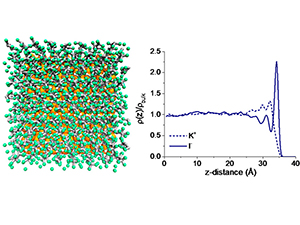Gating of Hydrophobic Nanopores with Large Anions
 ACS Nano 2020, 14, 4, 4306–4315
ACS Nano 2020, 14, 4, 4306–4315
Jake W. Polster, Elif Turker Acar, Fikret Aydin, Cheng Zhan, Tuan Anh Pham, and Zuzanna S. Siwy
The abstract reads as follows: Understanding ion transport in nanoporous materials is critical to a wide variety of energy and environmental technologies, ranging from ion-selective membranes, drug delivery, and biosensing, to ion batteries and supercapacitors. While nanoscale transport is often described by continuum models that rely on a point charge description for ions and a homogeneous dielectric medium for the solvent, here, we show that transport of aqueous solutions at a hydrophobic interface can be highly dependent on the size and hydration strength of the solvated ions. Specifically, measurements of ion current through single silicon nitride nanopores that contain a hydrophobic–hydrophilic junction show that transport properties are dependent not only on applied voltage but also on the type of anion. We find that in Cl–-containing solutions the nanopores only conducted ionic current above a negative voltage threshold. On the other hand, introduction of large polarizable anions, such as Br– and I–, facilitated the pore wetting, making the pore conductive at all examined voltages. Molecular dynamics simulations revealed that the large anions, Br– and I–, have a weaker solvation shell compared to that of Cl– and consequently were prone to migrate from the aqueous solution to the hydrophobic surface, leading to the anion accumulation responsible for pore wetting. The results are essential for designing nanoporous systems that are selective to ions of the same charge, for realization of ion-induced wetting in hydrophobic pores, as well as for a fundamental understanding on the role of ion hydration shell on the properties of solid/liquid interfaces.
This work was supported as part of the Center for Enhanced Nanofluidic Transport, an Energy Frontier Research Center funded by the U.S. Department of Energy, Office of Science, Basic Energy Sciences, under Award No. DE-SC0019112.
https://pubs.acs.org/doi/10.1021/acsnano.9b09777
